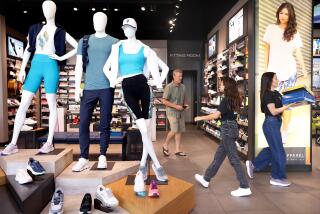Sneaker Firm Gains U.S. Foothold : Retailing: Based in Fountain Valley, the U.S. division of Japan’s Asics Tiger Corp. has found success with Western marketing techniques.
- Share via
In an age when lavish advertising for athletic shoes has every child dreaming of pumping up inflatable footwear or thinking more of Bo Jackson’s Nikes than his athletic prowess, it hardly seems as though there would be room for another sneaker.
But one Japanese-owned shoemaker says it is thriving as it jockeys for position among 39 name brands in the $6-billion U.S. market for athletic footwear.
Asics Tiger Corp. in Fountain Valley, the U.S. division of a Japanese athletic and apparel maker, says it has combined Eastern technology with Western marketing skills in a push to make inroads against industry leaders Nike Inc. and Reebok International Ltd., which collectively control about half of the market.
Asics’ running shoes are considered some of the industry’s most highly regarded products. The gel cushioning in the soles of most of its shoes has won plaudits from athletes and analysts alike. And the company’s success is reflected in a rapidly escalating sales curve.
In footwear alone, Asics’ sales have increased to $110 million in 1990, up from $43 million in 1986, according to the newsletter Sporting Goods Intelligence. The company now accounts for 2% of U.S. athletic footwear sales.
Asics expects $175 million in U.S. sales this year on its full line of shoes and apparel, up 45% from last year, according to H. Peter Goehrig, an Asics vice president. That gain would come amid an otherwise stagnant market for athletic footwear. As a result, Asics must boost market share by taking it from competitors.
“What we have tried to do is take away from competitors we most respect,” he said.
Practicing the fine art of guerrilla warfare as its applies to marketing--trying to make a big splash on a limited budget--Asics has produced a series of television advertisements that poke fun at its larger rivals.
In one, for instance, the basketball player wearing the Asics gel-cushioned shoes makes drive after drive to the basket. Another player wearing shoes that areinflated, just like Reebok’s “Pump” sneakers, stands helplessly on the sidelines trying to pump up his shoes. After trying to use a bicycle pump and a compressor, he never makes it to the court before the spot ends.
Asics offers technological innovation of its own. Asics shoes are lighter and have gel cushioning--silicone compound-filled pads placed in the arch and heel of many of its most popular shoes. The cushioning is supposed to dissipate the impact of running on hard surfaces and works well in hot or cold weather, the company says.
While marketing a full range of shoes, the company has gained a reputation for having among the best shoes available for specialized sports, such as wrestling and volleyball. But it is better known for having one of the more popular lines of running shoes.
“They are doing a very credible job,” said John Horan, publisher of Sporting Goods Intelligence. “Asics has done the best job of any in finding a niche--the performance running business.”
Mark Anderson, a footwear buyer for the Covina-based Chick’s Sporting Goods chain, said Asics competes with Nike as the best-selling running shoe for his chain of six stores, including three in Orange County.
“Asics is a good company to work with,” Anderson said. “The customers’ response currently is strong. They are a major player in the running category. . . . When you go to races, you see a lot of people in them.”
Anderson said that Asics’ popularity is due to a good quality product and smart marketing. The style of the shoes, much of it designed in Fountain Valley, and the color selections have been a hit, he said.
Asics was founded in Kobe, Japan, in the late 1940s by a Japanese veteran of World War II under the brand name of Tiger. In 1977, it merged with a Japanese apparel and sporting goods manufacturer. The new company was named Asics after the Latin phrase, anima sana in corpore sano-- a sound mind in a sound body.
Today, Asics Tiger is a $1.1-billion worldwide sporting goods conglomerate. Besides the shoes sporting its familiar intertwined stripe design that looks like a stylized Tic-Tac-Toe board, the company produces apparel and accessories ranging from ski wear and running suits to its own line of sunglasses and knee pads.
Best Foot Forward In the super-competitive world of athletic footwear, Nike and Reebok combined account for nearly half of all U.S. sales. LA Gear is a distant third. A host of other competitors, including Asics Tiger Corp., are battling it out for the rest of the market. Asics Sales in the U.S. In millions of dollars 1986: $43 1987: $56 1988: $73 1989: $95 1990: $110 Source: Sporting Goods Intelligence, 1991 The Athletic Shoe Market In percent of all athletic shoes sold in the U.S. in 1990: Reebok: 20.8% LA Gear: 12.0% Keds: 5.0%. Converse: 4.0% Adidas: 3.2% Avia: 2.6% British Knights: 2.6% Etonic: 2.2% Asics: 2.0% Nike: 28.4%
More to Read
Inside the business of entertainment
The Wide Shot brings you news, analysis and insights on everything from streaming wars to production — and what it all means for the future.
You may occasionally receive promotional content from the Los Angeles Times.










